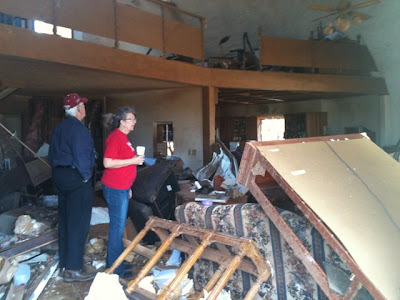I am up late reading the tornado news out of Moore, Oklahoma and other areas devastated by tornadoes in the past few days. My deepest condolences go out to all of the families who have lost their loved ones, their homes and their livelihoods.
This area, "Tornado Alley," is a very dangerous place to live during certain parts of the year because of these tornadoes. I happen to live at the very bottom of this zone in a Monolithic Dome. The tragic circumstances of yesterday bring some questions to mind.
 |
| Dome Sweet Dome during the rainy season. |
If we sent our loved ones to live on Mars, would we make sure their housing was strong enough to withstand the strongest Martian winds? Unquestionably.
 |
| Even in the artist's depiction of life on Mars in Cosmos Magazine, the conventional home is encased in a protective dome. |
Why then, do we persist in building stick houses in Tornado Alley?
At about 5:38 pm on a hot, humid afternoon, an EF4 tornado – possibly an EF5 – with winds of about 200 mph hit little Blanchard, Oklahoma and its 3225 residents.*
One of those homes – a thin shell concrete dome – constructed in 1981 by an independent builder took a direct hit.
According to The Monolithic Dome Institute,
"A few days after the tornado, Josh South of South Industries, Inc., who was in Oklahoma working on Monolithic Domes being built for a school in nearby Dale, visited Blanchard, talked with Debbie, inspected and photographed the dome.
Josh said that he could see that although the home was a thin shell concrete dome, it was not a Monolithic Dome. Josh sent the photographs and reported his findings to Mike South, vice-president/operations director at Monolithic.
Mike said, "Even in those early days (1981) of this technology, that dome was not properly reinforced. It was built primarily with steel fibers, had only a few steel reinforcing bars (rebar) running vertically but none running horizontally. Monolithic Domes are reinforced with rebar running in both directions. Its Airform had been removed so the urethane really got battered.
“If it was a Monolithic Dome, it wouldn’t have had any cracks in the shell whatsoever,” Mike added. “But it’s still a testament to the dome shape! What other shape could have survived that kind of destructive force?”
For argument's sake, let's say a tornado-proof home isn't an option. Then, why aren't our children protected in school buildings built to withstand Tornado Alley winds?
FEMA will even fund or partially fund storm shelters in these areas...shelters that can be schools and gymnasiums.
The Monolithic Dome Institute has been trying to get the word out and continues to try to make the world a safer place.
This is the 21st century...we know how to build beautiful, safe buildings. Let's build them and get on with living healthy, happy, safe lives!
*Update to article per E-mail exchange with Debbie Cox Leonard. The home described in this article was originally called the "Jones Residence." In actuality it belonged to the Cox family. Thank you to readers who care enough to send me corrections!















